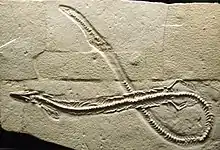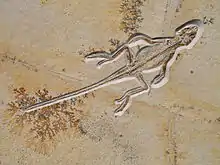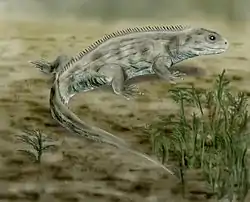Rhynchocephalia
Rhynchocephalia (/ˌrɪŋkoʊsɪˈfeɪliə/, "beak-heads") is an order of lizard-like reptiles that includes only one living species, the tuatara (Sphenodon punctatus) of New Zealand. Despite its current lack of diversity, during the Mesozoic the Rhynchocephalia included a wide array of genera within multiple (now extinct) lineages. The oldest known records of the group date to the Middle Triassic.[1] Most rhynchocephalians belong to the group Sphenodontia ("wedge-teeth"), which are characterized by a hooked beak-like structure at the tip of the snout formed by enlarged premaxillary teeth. Their closest living relatives are lizards and snakes in the order Squamata.
| Rhynchocephalians | |
|---|---|
.jpg.webp) | |
| Fossil of Vadasaurus, a rhynchocephalian from the Late Jurassic of Germany | |
 | |
| The tuatara, the only living rhynchocephalian | |
| Scientific classification | |
| Kingdom: | Animalia |
| Phylum: | Chordata |
| Class: | Reptilia |
| Superorder: | Lepidosauria |
| Order: | Rhynchocephalia Günther 1867 |
| Families | |
| |
Many of the niches occupied by lizards today were held by sphenodontians during the Triassic and Jurassic, although lizard diversity began to overtake sphenodontian diversity in the Cretaceous. While the modern tuatara is primarily carnivorous, there were also sphenodontians with omnivorous (Opisthias), herbivorous (Eilenodontinae), and durophagous (Oenosaurus) lifestyles. There were even several successful groups of aquatic sphenodontians, such as pleurosaurs and Ankylosphenodon.[2]
History of discovery
Tuatara were originally classified as agamid lizards when they were first described by John Edward Gray in 1831. They remained misclassified until 1867, when Albert Günther of the British Museum noted features similar to birds, turtles, and crocodiles. He proposed the order Rhynchocephalia (meaning "beak head") for the tuatara and its fossil relatives.[3] In 1925 Samuel Wendell Williston proposed the Sphenodontia to include only tuatara and their closest fossil relatives.[4] Sphenodon is derived from the Greek for "wedge" (σφήν/sphen) and "tooth" (ὀδούς/odous).[5][6][7] Many disparately related species were subsequently added to the Rhynchocephalia, resulting in what taxonomists call a "wastebasket taxon". These include the superficially similar (both in shape and name) but unrelated rhynchosaurs, which lived in the Triassic.[4] These were resolved after use of computer based cladistics, which showed the core sphenodontian grouping to be monophyletic.[8]
Classification and Anatomy
_601758.jpg.webp)

Sphenodonts, and their sister group Squamata (which includes lizards, snakes and amphisbaenians), belong to the superorder Lepidosauria, the only surviving taxon within Lepidosauromorpha. While the grouping of Rhynchocephalia is well supported, the relationships of many taxa to each other are uncertain, varying substantially between studies.[9] In modern cladistics, Sphenodontia includes all rhynchocephalians other than Gephyrosaurus, which has been found to be more closely related to squamates in some analyses.[8]
Squamates and sphenodonts both show caudal autotomy (loss of the tail-tip when threatened), and have transverse cloacal slits.[10] Like squamates, but unlike other reptiles, the tuatara possesses a parietal eye.[11] Rhynchocephalians are distinguished from squamates by a number of traits, including the presence of gastralia (rib-like bones present in the belly of the body, also shared with living crocodilians and some other extinct reptile groups, including most theropod dinosaurs), a narrow quadrate bone, the temporal fenestra (an opening of the skull) is enclosed or partially enclosed by bone, the jugal bones in the temporal arch touch the squamosal bone posteriorly, and a large coronoid process is present on the lower jaw.[10] In 2018, two additional clades of sphenodontians were defined, the infraorder Eusphenodontia which is defined by the least inclusive clade containing Polysphenodon, Clevosaurus hudsoni and Sphenodon, which is supported by the presence of three synapomorphies, including the presence of clearly visible wear facets on marginal teeth of the dentary or maxilla, the premaxillary teeth are merged into a chisel like structure, and the palatine teeth are reduced to a single tooth row, with the presence of an additional isolated tooth. The unranked clade Neosphenodontia (previously informally referred to as the "eupropalinals", in reference to the back and forward motion in the mouth during mastication), is defined as the most inclusive clade containing Sphenodon but not Clevosaurus hudsoni, which is supported by the presence of six synapomorphies, including the increased relative length of the antorbital region of the skull, reaching 1/4 to 1/3 of the total skull length, the posterior edge of the parietal bone is only slightly curved inward, the parietal foramen is found at the same level or forward of the anterior border of the supratemporal fenestra (an opening of the skull), the plalatine teeth are further reduced from the condition in eusphenodontians to a single lateral tooth row, the number of pterygoid tooth rows are reduced to one or none, and the posterior border of the ischium is characterised by a distinctive process.[12] The family Sphenodontidae has been used to include the tuatara and its closest relatives within Rhynchocephalia. However the grouping has lacked a formal definition, with the included taxa varying substantially between analyses.[8]
The dentition of most rhynchocephalians is described as acrodont (the condition where the teeth are attached to the crest of the jaw bone, and lack roots), similar to those of acrodontan lizards like agamids. The term "acrodont" has also been used in reference to the absence of tooth replacement or the extent of bone growth around the teeth, causing terminological confusion. The teeth of living tuatara have no roots and are not replaced, and are extensively fused to the jaw bone. The ancestral condition of rhyncocephalians was pleurodont (teeth are weakly attached to the inner part of the mandible with no sockets, and replaced throughout life), like those of most squamates. Some rhyncocephalians differ from these conditions, with Ankylosphenodon having teeth that continue deeply into the jaw bone, and are fused to the bone at the base of the socket (ankylothecodont).[13]
Paleobiology

Rhynchocephalians were once considered to be a morphologically conservative group with little diversity. However, discoveries in recent decades have disputed this, finding a wide array of diversity within the clade.[3] Early rhynchocephalians possess small ovoid teeth designed for piercing, and were probably insectivores.[14] Amongst the most distinct rhynchocephalians are the pleurosaurs, known from the Jurassic of Europe, which were adapted for aquatic life, with elongated snake-like bodies with reduced limbs, with the specialised Late Jurassic genus Pleurosaurus having a elongated triangular skull highly modified from those of other rhynchocephalians.[15] Several other lineages of rhyncocephalians have been suggested to have had semi-aquatic habits.[16] Eilenodontines are thought to have had a herbivorous habits, with batteries of wide teeth with thick enamel used to process plant material.[17] Oenosaurus and Sapheosaurus from the Late Jurassic of Europe possess broad tooth plates unique amongst tetrapods, and are thought to have been durophagous, with the tooth plates being used to crush hard shelled organisms.[18][8]
Evolutionary history

The oldest known remains of rhynchocephalians are indeterminate jaw fragments from the Erfurt Formation near Vellberg, Germany, dating to the Ladinian stage of the Middle Triassic, around 238-240 million years old.[1] Rhynchocephalians reached a worldwide distribution across Pangaea by the end of the Triassic, with the Late Triassic-Early Jurassic genus Clevosaurus having 10 species across Asia, Africa, Europe, North and South America.[19] During the Jurassic they reached their apex of morphological diversity, including specialised herbivorous and aquatic forms.[3] The only record of Rhynchocephalians from Asia are indeterminate remains of Clevosaurus from the Early Jurassic (Sinemurian) aged Lufeng Formation of Yunnan, China. Rhynchocephalians are noticeably absent from younger localities in the region, despite the presence of favourable preservation conditions.[20] They disappeared from North America and Europe after the Early Cretaceous,[21] and were absent from North Africa[22] and northern South America[23] by the early Late Cretaceous. The cause of the decline of Rhynchocephalia remains unclear, but has often been suggested to be due to competiton with advanced lizards and mammals.[24] They appear to have remained diverse in high-latitude southern South America during the Late Cretaceous, where lizards remained rare, with their remains outnumbering terrestrial lizards 200:1.[22] The youngest known remains of rhynchocephalians outside of New Zealand are those of Kawasphenodon peligrensis from the early Paleocene (Danian) of Patagonia.[25] Indeterminate sphenodontine jaw fragments bearing teeth are known from the early Miocene (19-16 million years ago) St Bathans fauna, New Zealand, that are indistinguishable from those of the living tuatara. It is unlikely that the ancestors of the tuatara arrived in New Zealand via oceanic dispersal, and it is thought that they were already present in New Zealand when it separated from Antarctica between 80 and 66 million years ago.[24]
Phylogeny
The following is a cladogram of Rhynchocephalia after Rauhut et al., 2012.[26]
| Rhynchocephalia |
| ||||||||||||||||||||||||||||||||||||||||||||||||||||||||||||||||||||||||||||||||||||||||||||||||||||||
References
- Jones ME, Anderson CL, Hipsley CA, Müller J, Evans SE, Schoch RR (September 2013). "Integration of molecules and new fossils supports a Triassic origin for Lepidosauria (lizards, snakes, and tuatara)". BMC Evolutionary Biology. 13: 208. doi:10.1186/1471-2148-13-208. PMC 4016551. PMID 24063680.
- Reynoso VH (2000). "An unusual aquatic sphenodontian (Reptilia: Diapsida) from the Tlayua Formation (Albian), central Mexico". Journal of Paleontology. 74: 133–148. doi:10.1017/s0022336000031310.
- Herrera-Flores JA, Stubbs TL, Benton MJ (2017). "Macroevolutionary patterns in Rhynchocephalia: is the tuatara (Sphenodon punctatus) a living fossil?". Palaeontology. 60 (3): 319–328. doi:10.1111/pala.12284. ISSN 1475-4983.
- Fraser N, Sues HD, eds. (1994). "Phylogeny" In the Shadow of the Dinosaurs: Early Mesozoic Tetrapods. Cambridge University Press. ISBN 0-521-45242-2.
- Evans SE, Prasad GV, Manhas BK (November 2001). "Rhynchocephalians (Diapsida: Lepidosauria) from the Jurassic Kota Formation of India". Zoological Journal of the Linnean Society. 133 (3): 309–34. doi:10.1111/j.1096-3642.2001.tb00629.x.
- "Sphenodon". Dictionary.com Unabridged (v 1.1). Random House, Inc. Retrieved 8 January 2007.
- Evans SE, Borsuk-Białynicka M (2009). "A small lepidosauromorph reptile from the Early Triassic of Poland" (PDF). Paleontologica Polonica. 65: 179–202.
- Simões TR, Caldwell MW, Pierce SE (December 2020). "Sphenodontian phylogeny and the impact of model choice in Bayesian morphological clock estimates of divergence times and evolutionary rates". BMC Biology. 18 (1): 191. doi:10.1186/s12915-020-00901-5. PMC 7720557. PMID 33287835.
- Romo de Vivar PR, Martinelli AG, Schmaltz Hsiou A, Soares MB (2020-07-02). "A New Rhynchocephalian from the Late Triassic of Southern Brazil Enhances Eusphenodontian Diversity". Journal of Systematic Palaeontology. 18 (13): 1103–1126. doi:10.1080/14772019.2020.1732488. ISSN 1477-2019. S2CID 216226211.
- Vitt LJ, Caldwell JP (2014). "Chapter 20: Rhynchocephalians (Sphenodontids)". Herpetology. Elsevier. pp. 553–554. doi:10.1016/b978-0-12-386919-7.00020-4. ISBN 978-0-12-386919-7.
- Dendy A (1911). "VI. On the structure, development and morphological interpretation of the pineal organs and adjacent parts of the brain in the tuatara ( sphenodon punctatus )". Philosophical Transactions of the Royal Society of London. Series B, Containing Papers of a Biological Character. 201 (274–281): 227–331. doi:10.1098/rstb.1911.0006. ISSN 0264-3960.
- Herrera-Flores JA, Stubbs TL, Elsler A, Benton MJ (2018-04-06). "Taxonomic reassessment of Clevosaurus latidens Fraser, 1993 (Lepidosauria, Rhynchocephalia) and rhynchocephalian phylogeny based on parsimony and Bayesian inference". Journal of Paleontology. 92 (4): 734–742. doi:10.1017/jpa.2017.136.
- Jenkins KM, Jones ME, Zikmund T, Boyde A, Daza JD (September 2017). "A Review of Tooth Implantation Among Rhynchocephalians (Lepidosauria)". Journal of Herpetology. 51 (3): 300–306. doi:10.1670/16-146. ISSN 0022-1511. S2CID 90519352.
- Jones ME (2009). Koppe T, Meyer G, Alt KW, Brook A (eds.). "Dentary Tooth Shape in Sphenodon and Its Fossil Relatives (Diapsida: Lepidosauria: Rhynchocephalia)". Frontiers of Oral Biology. Basel: Karger. 13: 9–15. doi:10.1159/000242382. ISBN 978-3-8055-9229-1. PMID 19828962.
- Klein N, Scheyer TM (February 2017). "Microanatomy and life history in Palaeopleurosaurus (Rhynchocephalia: Pleurosauridae) from the Early Jurassic of Germany". Die Naturwissenschaften. 104 (1–2): 4. doi:10.1007/s00114-016-1427-3. PMID 28005148.
- Bever GS, Norell MA (November 2017). "A new rhynchocephalian (Reptilia: Lepidosauria) from the Late Jurassic of Solnhofen (Germany) and the origin of the marine Pleurosauridae". Royal Society Open Science. 4 (11): 170570. doi:10.1098/rsos.170570. PMID 29291055.
- Jones ME, Lucas PW, Tucker AS, Watson AP, Sertich JJ, Foster JR, et al. (June 2018). "Neutron scanning reveals unexpected complexity in the enamel thickness of an herbivorous Jurassic reptile". Journal of the Royal Society, Interface. 15 (143): 20180039. doi:10.1098/rsif.2018.0039. PMC 6030635. PMID 29899156.
- Rauhut OW, Heyng AM, López-Arbarello A, Hecker A (2012). Farke AA (ed.). "A new rhynchocephalian from the late jurassic of Germany with a dentition that is unique amongst tetrapods". PloS One. 7 (10): e46839. doi:10.1371/journal.pone.0046839. PMC 3485277. PMID 23118861.
- Chambi-Trowell SA, Whiteside DI, Benton MJ, Rayfield EJ (November 2020). Lautenschlager S (ed.). "Biomechanical properties of the jaws of two species of Clevosaurus and a reanalysis of rhynchocephalian dentary morphospace". Palaeontology. 63 (6): 919–939. doi:10.1111/pala.12493.
- Jones MEH. 2006 The Early Jurassic clevosaurs from China (Diapsida: Lepidosauria). New Mex. Museum Nat. Hist. Sci. Bull. 37, 548–562.
- Cleary TJ, Benson RB, Evans SE, Barrett PM (March 2018). "Lepidosaurian diversity in the Mesozoic-Palaeogene: the potential roles of sampling biases and environmental drivers". Royal Society Open Science. 5 (3): 171830. Bibcode:2018RSOS....571830C. doi:10.1098/rsos.171830. PMC 5882712. PMID 29657788.
- Apesteguía S, Daza JD, Simões TR, Rage JC (September 2016). "The first iguanian lizard from the Mesozoic of Africa". Royal Society Open Science. 3 (9): 160462. Bibcode:2016RSOS....360462A. doi:10.1098/rsos.160462. PMC 5043327. PMID 27703708.
- Simões TR, Wilner E, Caldwell MW, Weinschütz LC, Kellner AW (August 2015). "A stem acrodontan lizard in the Cretaceous of Brazil revises early lizard evolution in Gondwana". Nature Communications. 6 (1): 8149. Bibcode:2015NatCo...6.8149S. doi:10.1038/ncomms9149. PMC 4560825. PMID 26306778.
- Jones ME, Tennyson AJ, Worthy JP, Evans SE, Worthy TH (April 2009). "A sphenodontine (Rhynchocephalia) from the Miocene of New Zealand and palaeobiogeography of the tuatara (Sphenodon)". Proceedings. Biological Sciences. 276 (1660): 1385–90. doi:10.1098/rspb.2008.1785. PMC 2660973. PMID 19203920.
- Apesteguía S, Gómez RO, Rougier GW (October 2014). "The youngest South American rhynchocephalian, a survivor of the K/Pg extinction". Proceedings. Biological Sciences. 281 (1792): 20140811. doi:10.1098/rspb.2014.0811. PMC 4150314. PMID 25143041.
- Rauhut OW, Heyng AM, López-Arbarello A, Hecker A (2012). Farke AA (ed.). "A new rhynchocephalian from the late jurassic of Germany with a dentition that is unique amongst tetrapods". PLOS ONE. 7 (10): e46839. Bibcode:2012PLoSO...746839R. doi:10.1371/journal.pone.0046839. PMC 3485277. PMID 23118861.
Further reading
- Apesteguia S, Rougier GW (2007). "A Late Campanian Sphenodontid Maxilla from Northern Patagonia" (PDF). American Museum Novitates. 3581: 1–12. doi:10.1206/0003-0082(2007)3581[1:ALCSMF]2.0.CO;2. Retrieved 2019-03-30.
- Daugherty CH, Cree A, Hay JM, Thompson MB (1990). "Neglected taxonomy and continuing extinctions of tuatara (Sphenodon)". Nature. 347 (6289): 177–179. Bibcode:1990Natur.347..177D. doi:10.1038/347177a0. S2CID 4342765.
- Evans SE (November 2003). "At the feet of the dinosaurs: the early history and radiation of lizards". Biological Reviews of the Cambridge Philosophical Society. 78 (4): 513–51. doi:10.1017/S1464793103006134. PMID 14700390. S2CID 4845536.
- Jones ME (August 2008). "Skull shape and feeding strategy in Sphenodon and other Rhynchocephalia (Diapsida: Lepidosauria)". Journal of Morphology. 269 (8): 945–66. doi:10.1002/jmor.10634. PMID 18512698. S2CID 16357353.
- Jones ME (2009). "Dentary tooth shape in Sphenodon and its fossil relatives (Diapsida: Lepidosauria: Rhynchocephalia).". In Koppe T, Meyer G, Alt KW (eds.). Interdisciplinary Dental Morphology. Frontiers of Oral Biology. 13. Greifswald, Germany: Karger. pp. 9–15.
- Evans SE, Jones ME (2010). "The Origin, early history and diversification of lepidosauromorph reptiles.". In Bandyopadhyay S (ed.). New Aspects of Mesozoic Biodiversity , 27 Lecture Notes in Earth Sciences. Lecture Notes in Earth Sciences. 132. pp. 27–44. doi:10.1007/978-3-642-10311-7_2. ISBN 978-3-642-10310-0.
- Gemmell NJ, Rutherford K, Prost S, Tollis M, Winter D, Macey JR, et al. (August 2020). "The tuatara genome reveals ancient features of amniote evolution". Nature. 584 (7821): 403–409. doi:10.1038/s41586-020-2561-9. PMC 7116210. PMID 32760000.
External links
 Media related to Sphenodontidae at Wikimedia Commons
Media related to Sphenodontidae at Wikimedia Commons Data related to Rhynchocephalia at Wikispecies
Data related to Rhynchocephalia at Wikispecies
